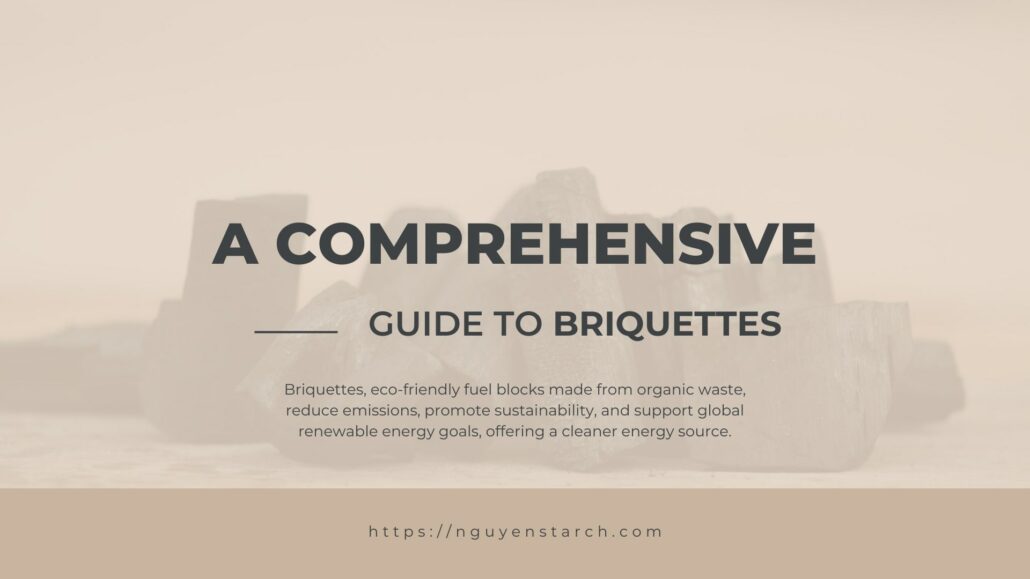Briquettes, eco-friendly fuel blocks made from organic waste, reduce emissions, promote sustainability, and support global renewable energy goals, offering a cleaner energy source.
What are briquettes
Briquettes are compact blocks or logs of fuel that are typically made by compressing biomass materials, such as agricultural residues, wood chips, sawdust, or charcoal dust. These blocks are used as a source of energy for various purposes, including heating, cooking, and industrial processes.
Briquettes are designed to be a more efficient and environmentally friendly alternative to traditional fuels like firewood or charcoal. They come in different shapes and sizes and are often produced with the help of a briquette machine.
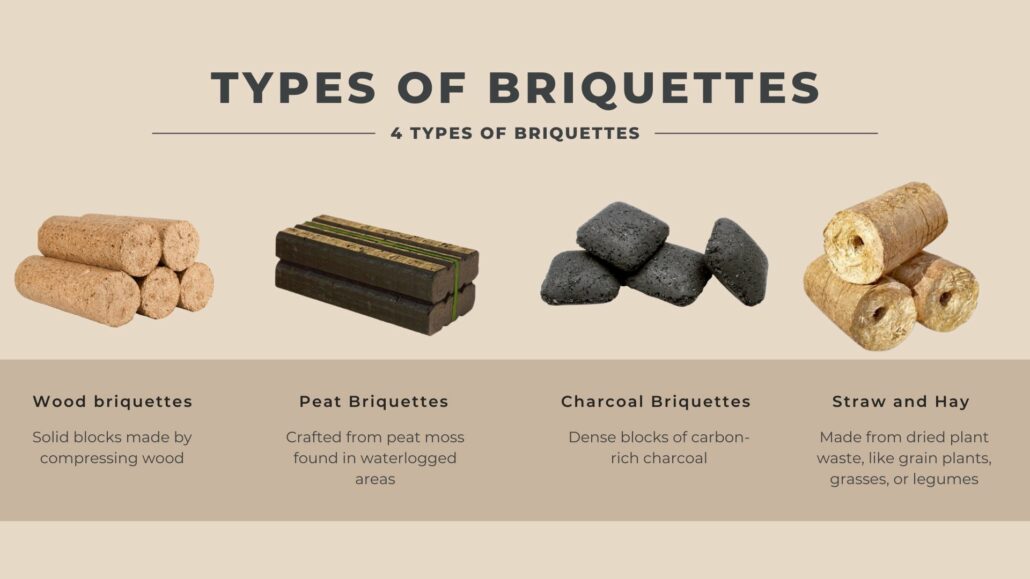
Types of briquettes
There are different types of briquettes made from materials like wood, peat, charcoal, straw, and hay, each with its own way of working.
Wood briquettes
Wood briquettes are solid blocks made by compressing wood or wood residues. They are excellent for heating because they produce a lot of heat for their size. Wood briquettes are easy to store and handle, making them ideal for use in fires, stoves, and heaters. They are eco-friendly since they are made from waste wood and reduce the need for fossil fuels. Plus, they produce less carbon gas.
Peat briquettes
Peat briquettes are crafted from peat moss found in waterlogged areas called bogs. To make these briquettes, peat is extracted, dried to reduce moisture, and then compacted under high pressure.
Binders or additives may be used to enhance their properties. Peat briquettes offer a slow, efficient burn, providing even heat distribution. However, using peat for fuel can harm ecosystems and reduce biodiversity.
Charcoal briquettes
Charcoal briquettes are dense blocks of carbon-rich charcoal used for cooking and grilling. They are made by heating wood or organic material without oxygen, resulting in charcoal.
Charcoal is mixed with other substances and molded into briquettes. These briquettes have consistent size and shape, making them easy to handle, stack, and ignite. They burn longer, produce less smoke and ash, but may contain chemicals.
Straw and hay briquettes
Straw and hay briquettes are made from dried plant waste, like grain plants, grasses, or legumes, collected from farms. Briquette machines process and compress this material under high pressure, sometimes with binders. They are an eco-friendly way to manage farm waste and can be used for heating or cooking. These briquettes are readily available, cost-effective, and have a low environmental impact due to their carbon neutrality.
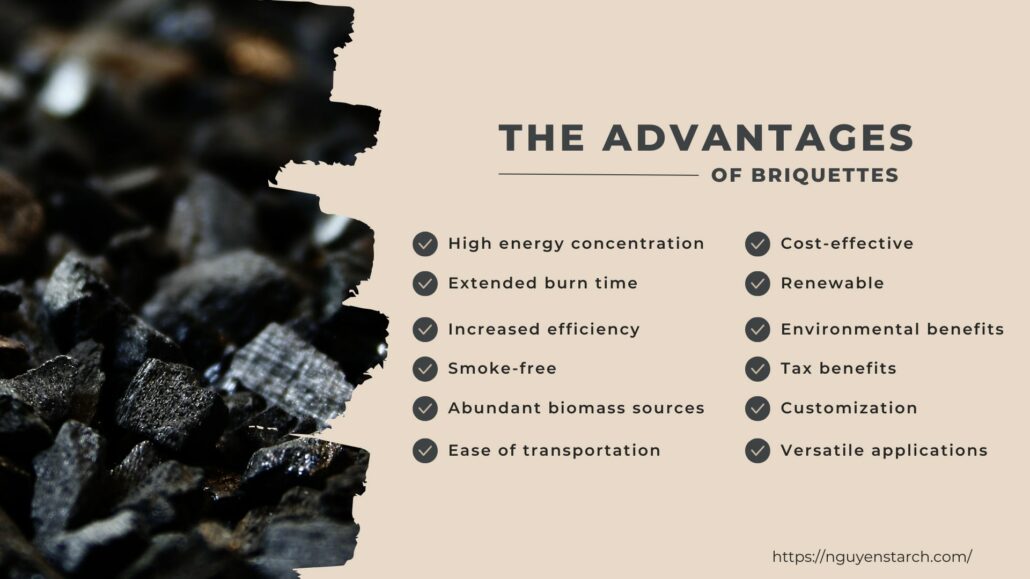
The advantages of briquettes
The advantages of briquettes make them an attractive and sustainable alternative to traditional fuels, offering benefits in terms of efficiency, environmental impact, cost-effectiveness, and convenience.
High energy concentration
Briquettes are denser and more compact than loose biomass, resulting in a higher specific density and bulk density. This means they contain a concentrated form of energy compared to firewood or charcoal.
Extended burn time
Briquettes burn for longer periods than loose materials, providing prolonged heat.
Increased efficiency
Briquettes offer greater heating value with a high calorific value compared to other fuels. They also produce less ash (2-10% as opposed to 20-40% in coal) and are about 40% more efficient. This increased efficiency is due to their low moisture content and density.
Smoke-free
Briquettes do not produce smoke, soot, or carbon deposits when burned. Depending on the base material, they may generate minimal to no fly ash. They also do not emit harmful gases or toxic chemicals like sulfur.
Abundant biomass sources
Biomass, the primary component in briquettes, is widely available from various sources.
Ease of transportation
Compressed briquettes take up less space, making them easier to store and transport compared to loose biomass waste. Their shape, size, and density make them ideal for long-distance transport and reduce loading and unloading costs.
Cost-effective
Briquettes can be produced locally from plant and animal waste, resulting in lower production costs and lower prices for consumers.
Renewable
Briquettes utilize organic materials that are renewable and sustainable, ensuring a long-lasting source of fuel.
Environmental benefits
The use of briquettes can reduce the reliance on fossil fuels, decrease deforestation, and mitigate environmental damage caused by traditional fuels like firewood and charcoal.
Tax benefits
In some regions, there may be tax exemptions or incentives for using briquettes, promoting their adoption.
Customization
Briquettes can be tailored to specific uses, such as producing low-smoke variants or those suitable for particular types of stoves or applications.
Versatile applications
Briquettes can be used for various purposes, including heating homes, cooking, industrial processes, and power generation.
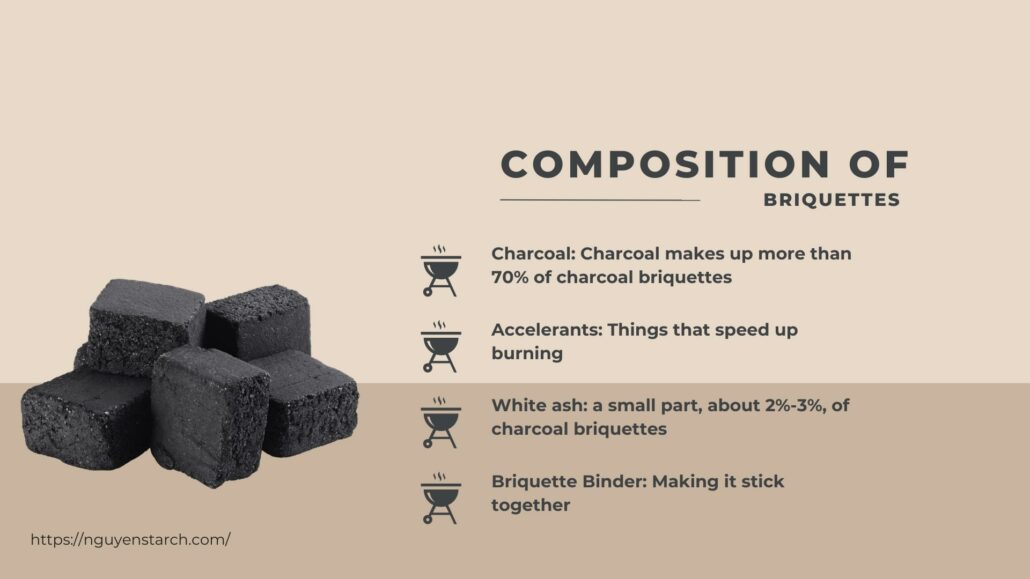
What Charcoal Briquettes Are Made Of
Charcoal briquettes have two main parts: the charcoal that provides heat and some other ingredients. Charcoal is made from wood or wood materials that didn’t burn completely or under specific conditions without air.
Part 1: Charcoal
Charcoal makes up more than 70% of charcoal briquettes. It’s the stuff that actually burns to give heat. Charcoal can come from different types of wood like beech, birch, hard maple, pecan, or oak.
Charcoal is usually made in a kiln. There are two kinds: black wood charcoal and white wood charcoal. Black wood charcoal lights up easily but can explode and creates a lot of smoke. White wood charcoal, on the other hand, gets turned into white ash after it’s made and is harder.
Part 2: Things that speed up burning (Accelerants)
Charcoal briquettes don’t get much air while burning, so they need something to help them burn faster. The best thing for this is nitrate because it gives oxygen for burning and extra heat. But nitrate is costly. A cheaper way is to add 10%-20% sawdust, which helps speed up the burning.
Part 3: White ash
White ash is a small part, about 2%-3%, of charcoal briquettes. Even though it’s a tiny bit, it’s vital for how briquettes burn. When you see the charcoal turning white, it tells you how much it has burned. Plus, white ash doesn’t burn, so it keeps the briquette burning longer.
Part 4: Making it stick together (Briquette Binder)
Charcoal powder isn’t good at sticking together by itself, so a binder is added. About 5%-7% of the briquette is binder. Starch is the best binder because when it turns into a gooey paste, it holds the charcoal powder together. Another option is Arabic gum or acacia gum, but they cost more. The cheapest choice is waste paper pulp.
Different mixtures make different briquettes. Here are some recipes:
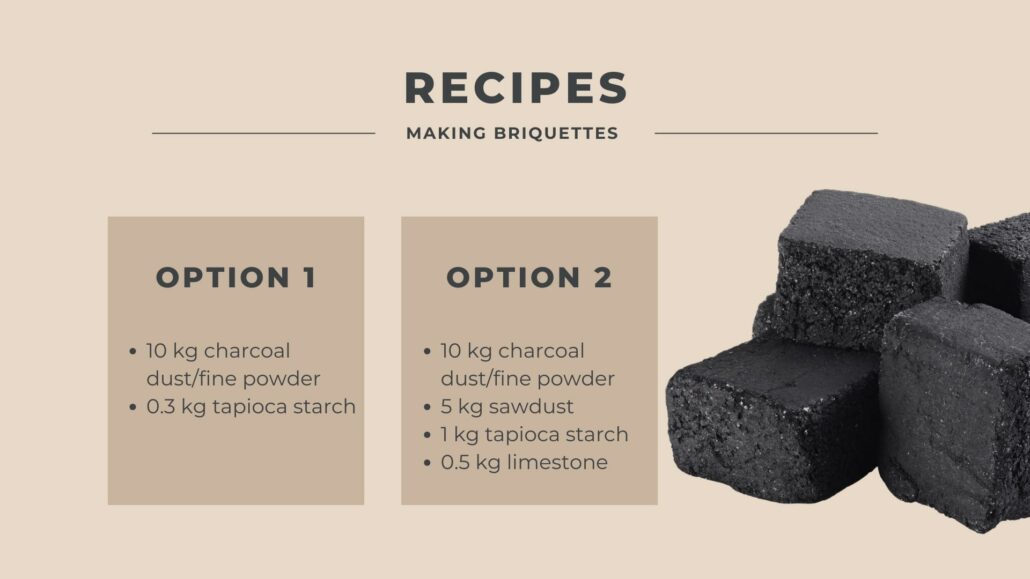
Option 1:
- 10 kg charcoal dust/fine powder
- 0.3 kg tapioca starch
Option 2:
- 10 kg charcoal dust/fine powder
- 5 kg sawdust
- 1 kg tapioca starch
- 0.5 kg limestone
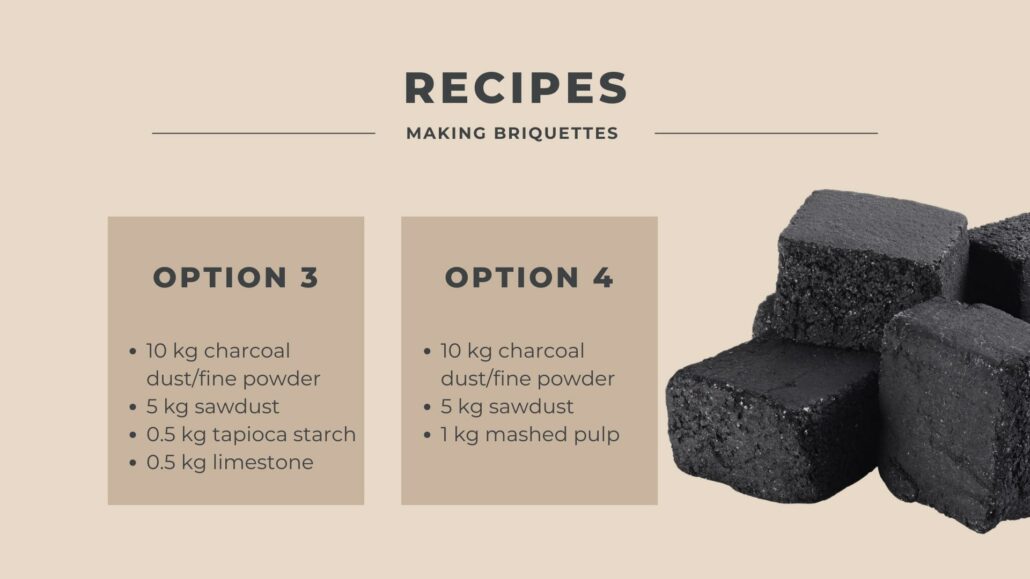
Option 3:
- 10 kg charcoal dust/fine powder
- 5 kg sawdust
- 0.5 kg tapioca starch
- 0.5 kg limestone
Option 4:
- 10 kg charcoal dust/fine powder
- 5 kg sawdust
- 1 kg mashed pulp
Advantages of charcoal briquettes
- They burn well (more than 80% of the briquette turns to heat)
- They burn for a long time and stay steady
- They don’t make smoke or have a strong taste
- They’re lighter (only 1/5 to 1/3 of their original weight)
- They’re cheaper than regular charcoal
- They’re easy to carry, pack, transport, and use
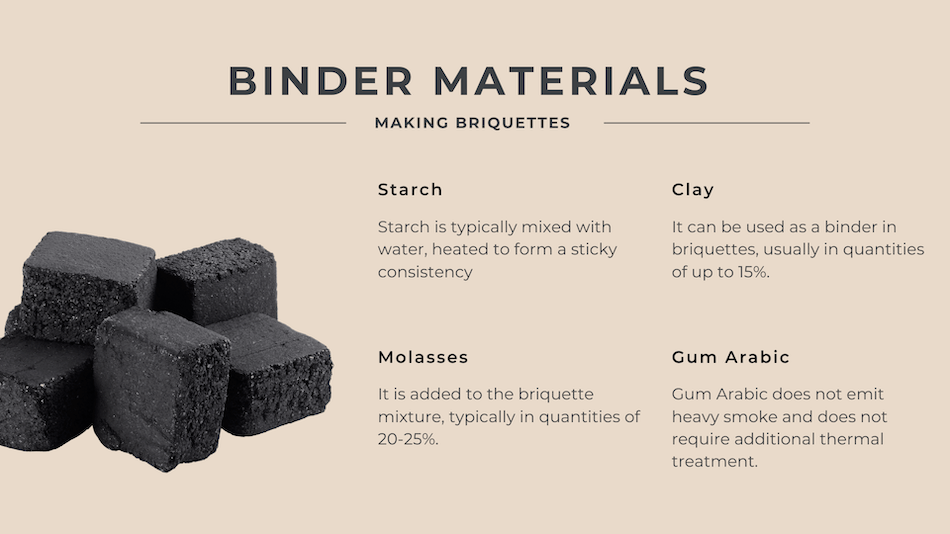
Choosing Binder Materials
Binder materials for briquetting are substances used to hold the particles of the briquette together, ensuring it maintains its shape and integrity during transportation, storage, and use. These binders are essential in the briquetting process, particularly when dealing with materials that lack natural adhesive properties. Common binder materials for briquetting include:
Starch
Starch is a widely used binder for briquettes. It is available in various forms, such as corn starch, wheat starch, maize flour, rice flour, tapioca starch (cassava flour), and potato starch. Starch is typically mixed with water, heated to form a sticky consistency, and then added to the briquette mixture.
Clay
Clay is readily available and inexpensive in many areas. It can be used as a binder in briquettes, usually in quantities of up to 15%. However, excessive clay can hinder combustion and lead to the formation of ash.
Molasses
Molasses is a by-product of the sugarcane industry and can serve as a binder in briquettes. It is added to the briquette mixture, typically in quantities of 20-25%. Briquettes bound with molasses may produce an odor during combustion, which can be reduced through a curing process.
Gum Arabic
Gum Arabic, also known as acacia gum, is a natural gum harvested from acacia trees, commonly found in regions like Africa’s Sahel. It can be used as a binder material for charcoal briquettes. Gum Arabic does not emit heavy smoke and does not require additional thermal treatment.
Wood Tar and Pitch
Wood tar and pitch are by-products obtained during the carbonization process. These substances can serve as binders, but they may require re-carbonization to prevent the emission of heavy smoke during combustion.
Cow Dung
In some rural areas, cow dung is used as a binding material for briquettes. It is an easily accessible and cost-effective option.
Paper Pulp
Soaked waste paper pulp can also be used as a binder in briquettes, especially when recycling paper waste.
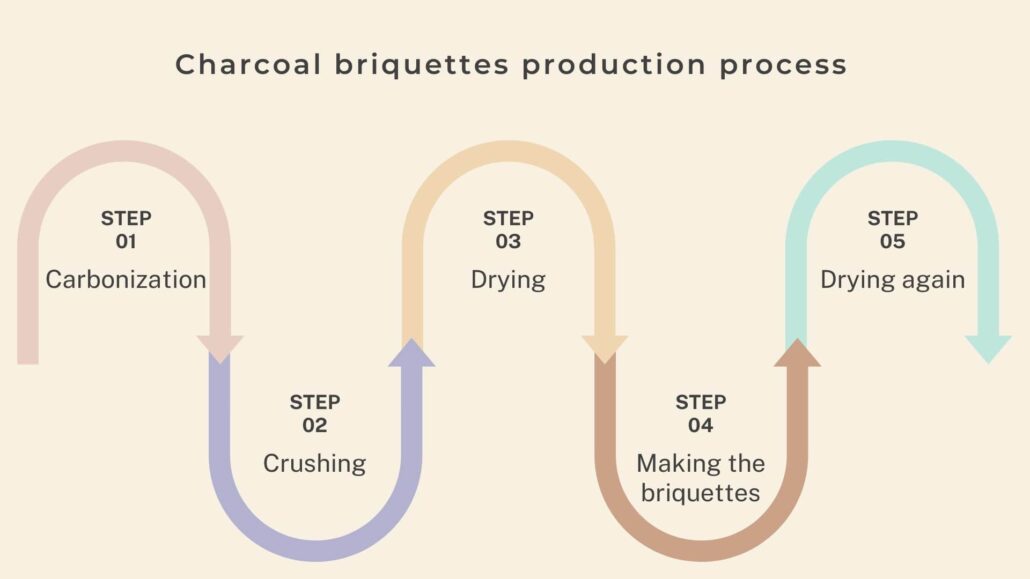
Charcoal briquettes production process
Creating charcoal briquettes involves five main steps. Let’s break them down:
Step 1: Carbonization
First, you need to heat up the raw materials in a special oven called a rotary kiln. This heating process takes about a week, and you have to keep the temperature between 840-950 °F (450-510 °C).
Once the heating is done, close the air inlet and wait for one to two hours to let out any remaining gases. After that, cool down the kiln for about two weeks. Then, you can empty it and crush the charcoal created during this process.
Step 2: Crushing
To turn the charcoal into small pieces, you can use a hammer crusher or roller crusher. Different types of wood may need different sizes, but generally, you want to crush them into bits smaller than 5mm to make good-quality charcoal briquettes.
Step 3: Drying
Now, the crushed charcoal needs to dry. If it has too much water, it can heat up quickly and even explode. But if it’s too dry, it won’t stick together well. So, use a dryer to reduce its moisture content by about half, usually down to around 15%.
Step 4: Making the briquettes
This is a crucial step. When you feed the dried charcoal into the briquette machine, three things happen:
- The machine’s main force shapes the charcoal.
- Friction helps hold it together.
- The machine’s walls push it into shape.
Thanks to a bit of moisture, some sticky stuff, a temperature of about 105 °F (40 °C), and the pressure from the machine’s rollers, the charcoal briquettes keep their shape when they come out of the machine.
Step 5: Drying again
Finally, toss the charcoal briquettes into a dryer for about three to four hours. This will heat them up to 275 °F (135 °C) and reduce the moisture to about 5%.
Once they’re made, you can either bag them up right away or store them in silos. By following these steps, you can produce charcoal briquettes at a rate of 2200-20,000 pounds (1-9 metric tons) per hour.
Applications of briquettes across industries
Briquettes find utility across a wide range of industries, serving as an efficient and versatile energy source. Here’s how they are applied:
Gasifier System Applications: Used as a fuel source in gasifier systems.
Ceramic Industries: Utilized for heating and powering processes in ceramic production.
Refractory Industries: Provide heat for various applications in refractory manufacturing.
Solvent Extraction Plant: Used as a cost-effective energy source in solvent extraction processes.
Chemical Industries: Serve as a reliable energy input for diverse chemical manufacturing operations.
Dyeing Units: Used in dyeing processes to meet energy needs efficiently.
Milk Plant: Play a crucial role in heating and processing dairy products.
Food Processing Industries: Power equipment and machinery involved in food processing.
Vegetable Plants: Provide thermal energy for vegetable processing operations.
Textile Unit: Essential for heating and power generation in textile facilities.
Spinning Mill: Used as an energy source in spinning mills for textile production.
Lamination Industries: Support heat-intensive processes in lamination manufacturing.
Leather Industries: Used for heating and other thermal requirements in leather processing.
Brick Making Units: Serve as a reliable fuel source in brick manufacturing.
Rubber Industries: Provide energy for rubber processing and molding operations.
Any Industrial Thermal Application: Suitable for a wide array of thermal applications across industries.
Power Plant: Used as fuel in power generation plants.
Food Industry: Serve as an energy source in various aspects of food production and preparation.
Challenges in the Briquettes Industry
The biomass briquettes industry encounters several challenges:
Raw Material Availability and Quality: A major challenge is ensuring a consistent supply of high-quality biomass. The quality of briquettes depends on the materials used, so a reliable source of top-notch biomass is crucial.
Production Costs: Making biomass briquettes can sometimes be more expensive than traditional fuels like coal, especially if raw materials must travel long distances. This cost difference can hinder the industry’s competitiveness.
Lack of Standards: There isn’t a universal standard for biomass briquettes, making it hard for buyers to assess their quality. This lack of standardization raises concerns about quality control and performance consistency.
Competition from Other Energy Sources: Biomass briquettes face competition from cheaper and more user-friendly renewable energy sources like solar, wind, and hydroelectric power.
Limited Awareness and Infrastructure: The industry needs to educate people about the benefits of biomass briquettes as a fuel source. Additionally, investments in machinery and storage facilities are essential for supporting the industry’s growth.
While these challenges exist, the biomass briquettes industry also holds great potential for expansion as more individuals and businesses seek sustainable and renewable energy options.
The Promising Future of Biomass Briquettes
The biomass briquette industry is growing and has great potential for the future. As the world looks to use more renewable energy and eco-friendly methods, biomass briquettes are becoming a smart choice instead of old-fashioned fuels. Let’s look at why the biomass briquette industry will likely grow and succeed.
More Demand for Renewable Energy
People are worried about climate change and want to reduce pollution. So, they’re asking for renewable energy sources. Biomass briquettes, made from stuff like old crops, wood waste, and other natural materials, are one way to get eco-friendly energy. As countries aim to use more renewable energy, the need for biomass briquettes will grow.
Supportive Government Policies
Governments around the world are passing laws to help biomass briquettes. They’re giving money, tax breaks, and other benefits to make biomass briquettes. This helps the industry a lot and brings in more money.
Better Technology
People are always finding better ways to make biomass briquettes. They’re improving the machines, ways to dry the materials, and how to make the briquettes stick together. This means better quality and lower prices. These tech improvements are a big part of the industry’s growth.
Helping the Environment
Using biomass briquettes is good for the planet. They make less pollution compared to old fuels like coal. This helps cut down on harmful gases and makes the air cleaner. Plus, using waste materials for briquettes is good for the environment because it reduces trash.
Many Uses and New Markets
People are finding new ways to use biomass briquettes. They’re not just for making power; you can use them in factories, cooking, heating, and more. As people learn about them, new markets and jobs will come up, making the industry bigger.
Supporting Recycling and Using Resources Well
Biomass briquettes fit in with recycling and using things better. They take stuff like old plants and forest waste and turn it into useful energy. This is a smart way to manage resources and helps the planet.
International Opportunities
Biomass briquettes are getting known worldwide. More countries see the value of clean energy and eco-friendly practices. This means companies can sell their briquettes to other countries, which is good for business and growth.
We specialize in producing tapioca starch for briquettes as a binder. If you have any inquiries about tapioca starch, please get in touch with us:
NguyenStarch – Vietnam Tapioca Starch Manufacturer and Supplier
Website: https://nguyenstarch.com/
Phone: +84 988 791 033
Email: nguyenbaotinvn@gmail.com

